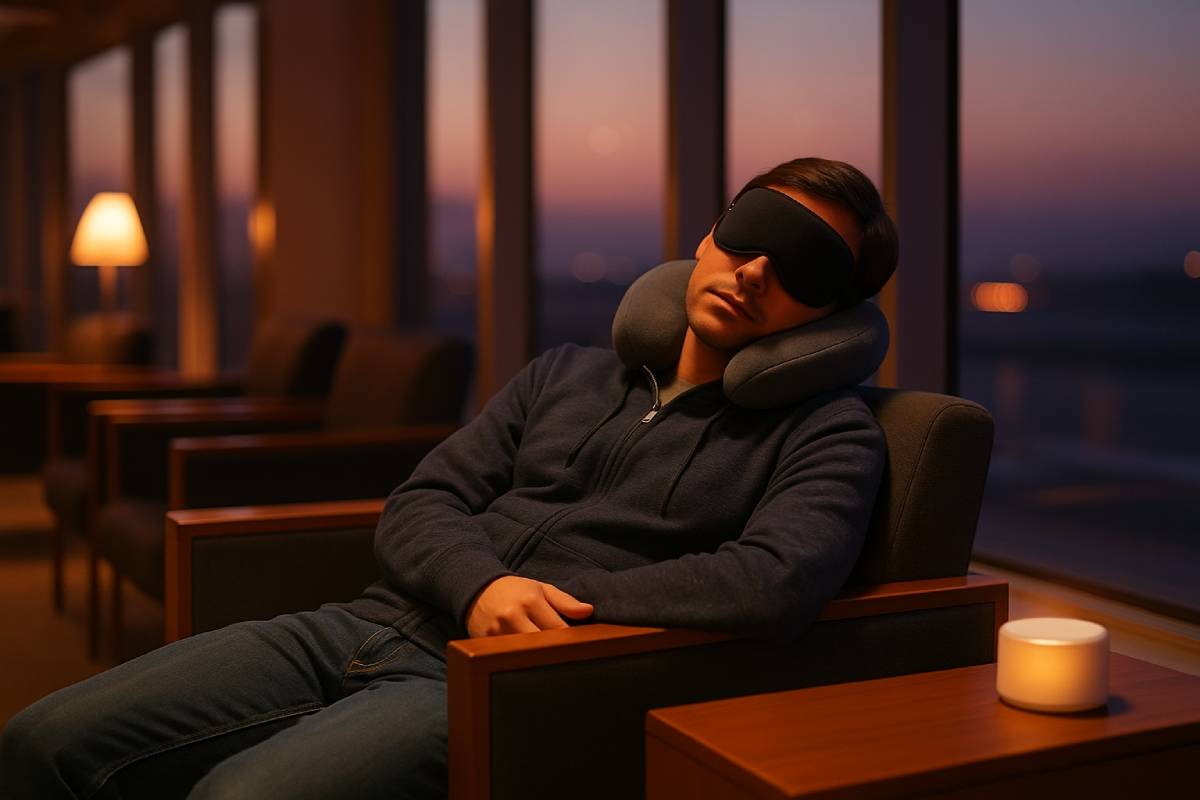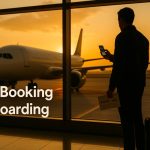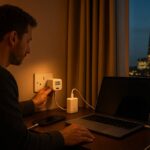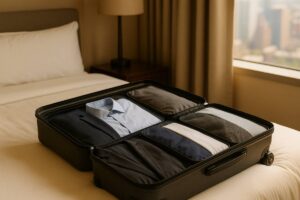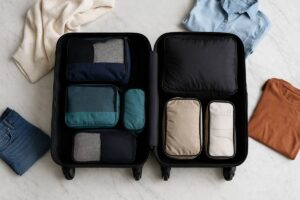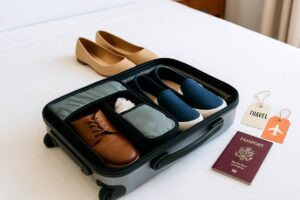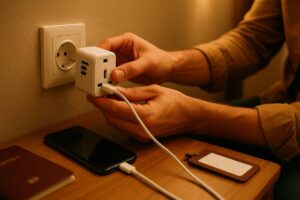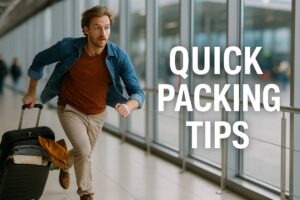Tossing and turning on a cramped flight or restless in a strange hotel room doesn’t have to be your travel norm.
With a few scientifically backed tactics—like pre-adjusting your sleep schedule, packing the right “sleep kit,” and using light and meal cues—you’ll beat jet lag before your plane even lands.
Experts agree that aligning meals and sleep to your destination’s clock, plus masking noise and light with portable devices, can slash recovery time from a week to just a couple of days.
Whether you’re trekking east or west, business or backpacking, these practical tips will have you waking up energized and ready for adventure.
Pre-Travel Preparation
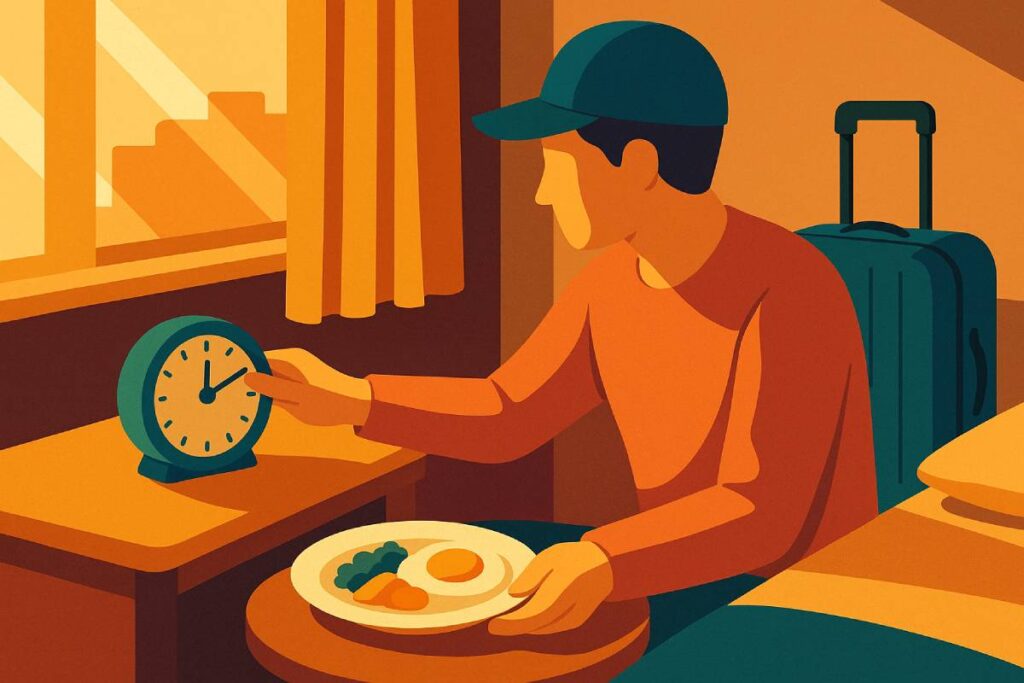
Laying the groundwork before you even pack your bags can make the difference between arriving rested and struggling through your first day. Two pillars of effective pre-travel preparation are gradually shifting your sleep schedule to match your destination’s time zone and assembling a focused sleep checklist so you have the right tools on hand.
Below, we break down how to execute both strategies and the real-world impact you can expect.
1. Gradually Shift Your Sleep Schedule
- Start 3–4 days before departure.
Rather than waiting until you land, begin moving your bedtime and wake-up time by about one hour per day in the direction of your destination’s clock. - Small increments prevent sleep debt.
Adjusting by an hour or less each day helps your body adapt without piling on fatigue, keeping you sharp for last-minute planning. - Leverage strategic light exposure.
Morning light exposure if you’re advancing your schedule, or evening light if you’re delaying it, reinforces your new rhythm. - Real-world gains:
- A controlled study found that phase-delaying your sleep by up to 2.4 hours per day can shift your internal clock by nearly 9.6 hours over four days, smoothing the transition across multiple time zones.
- Without pre-adjustment, travelers typically require one day of recovery per time zone crossed, meaning a 12-hour shift could take 12 days to fully resynchronize.
- Personalized pre-travel plans (e.g., via Timeshifter) have demonstrated slashing recovery time from 13 days to just 4 days for a 12-hour difference—a 67 % reduction in jet-lag duration.
Recovery Time Comparison
| Time Zones Crossed | Baseline Recovery (1 day per zone) | With Pre-Travel Adjustment | Reduction |
|---|---|---|---|
| 12 | 12 days | 4 days | 67 % |
Compile a Travel Sleep Checklist
Stocking up on a handful of high-impact accessories ensures you can recreate a restful environment anywhere:
- Memory-foam travel pillow for cervical support, preventing neck strain in upright seats.
- Contoured eye mask to block ambient and cabin lighting completely.
- High-NRR earplugs (Noise Reduction Rating ~32 dB) to mute engine hum and chatter.
Combined Efficacy of Masks & Plugs:
A meta-analysis showed that using eye masks and/or earplugs increased total sleep time by 25 minutes, improved sleep efficiency by 6 %, and extended REM sleep by 4.7 % in controlled settings.
Traveler Outcomes:
Among 130,000+ users of personalized jet-lag apps, those who followed a full pre-travel sleep plan were 14.1 times less likely to report severe jet lag, and 96.4 % crossed time zones “without feeling jet-lagged.”
By combining a gentle, phased sleep shift with a lightweight but powerful sleep kit, you’ll board your trip feeling empowered and arrive at your destination ready to perform.
Transportation-Specific Tips
Across all transportation modes, targeted strategies can turn cramped seats and noisy terminals into surprisingly restful environments. Choosing a window seat on planes provides a stable surface to lean against and can reduce cabin noise by up to 4 dB, significantly boosting sleep chances mid-flight.
On trains, securing a spot in a quiet car and packing earplugs, a blanket, and a travel pillow transforms even crowded compartments into a restful cocoon with comfort train sleep.
Road travelers benefit from strategic breaks and short power naps—sleeping 15–20 minutes in a safely reclined seat can restore alertness and reduce fatigue. And when you’re on an overnight bus, scouting quieter terminal zones and using an eye mask plus earplugs shields you from light and noise, making every red-eye route manageable.
Airplane
Maximize your in-flight sleep by optimizing both seat choice and sleep aids. The window seat is universally recognized as the best option for resting—its rigid wall support lets you lean comfortably, and being forward of the engine can cut cabin noise by about 4 dB.
Pack a memory-foam neck pillow, a contoured eye mask, and noise-canceling headphones to block light and muffle engine hum or chatty seatmates. Together, these accessories create a mini “sleep bubble,” letting you drift off despite cabin disturbances and maximizing any available shut-eye.
Train
Rail travel offers unique comforts—quiet cars and sleeper berths—but you still need the right kit. Aim for a seat in a designated quiet car or, if available, a private cabin to minimize foot-traffic noise.
Bring a lightweight blanket to stay warm against unpredictable air-conditioning, earplugs to mute rolling stock sounds, and a compact travel pillow to support your neck when you doze by the window. Layering soft sleepwear and using a sleep mask can further signal your body that it’s time to rest.
Car
Whether you’re a passenger or planning a driver-swap and want some Sleep Solutions for Car Travel, safety and comfort go hand in hand. Schedule regular stops—ideally every 1.5–2 hours—to stretch, hydrate, and reset focus. If drowsiness strikes, pull over to a safe area and let yourself nap for 15–20 minutes; short power naps sharply boost alertness without deep-sleep grogginess.
For passengers, recline your seat slightly (while keeping your seatbelt fastened) to relax your spine and use an eye mask or earplugs to recreate a dark, quiet environment. And when possible, alternate drivers so everyone stays safe and refreshed on long road trips.
Bus
Overnight buses demand both planning and compact gear. Scout quieter waiting areas or lounges in the terminal—far from ticket counters and boarding gates—to begin your journey undisturbed.
At the seat, don an eye mask to block harsh overhead lights and use earplugs to muffle engine rattles or fellow passengers. If your bus allows, lean against the window and tuck a travel pillow behind your neck to maintain alignment while you steal precious hours of rest.
By tailoring sleep tactics to each mode’s environment—airplane, train, car, or bus—you can transform travel from endurance to ease and arrive refreshed no matter how far you roam.
Environmental Control Strategies
Creating a consistent, bedroom-like environment on the go can dramatically improve sleep quality, even in the noisiest or most unfamiliar settings. Three key tools—portable white noise machines, high-performance eye masks, and temperature-regulating layers—work together to mask disruptions, block light, and maintain optimal sleep temperatures.
Portable White Noise Machines
White noise machines generate a steady, broadband sound that masks disruptive noises, promoting deeper, uninterrupted sleep. Travel-specific models like the LectroFan EVO offer up to 22 customizable sounds and USB power in a compact, 0.8-pound package, earning a 4.5-star rating for effectively drowning out urban noise.
Similarly, the Momcozy Sunrise Sound Machine provides 30 high-fidelity sounds—including nature and fan tones—on a battery-powered, ultra-portable unit that also soothes infants.
| Device | Price | Sound Library | Power Source |
|---|---|---|---|
| LectroFan EVO | $59.95 | 22 sounds | USB-powered |
| Momcozy Sunrise Sound Machine | $40 | 30 sounds | Battery (6 hr) |
Eye Masks
An effective eye mask blocks residual light, preventing it from disrupting melatonin production and helping you fall asleep faster and stay asleep longer. Weighted or contoured masks—such as the MZOO and Tempur-Pedic models—apply gentle pressure that cues your brain for rest, with some users reporting up to a 15 % increase in sleep efficiency.
For targeted relief, heated eye massagers like the Bob and Brad EyeOasis 2 feature two heat settings and three compression levels to ease eye strain and tension. Meanwhile, smart sleep masks—for example, the Aura Smart Sleep Mask—integrate ultra-thin speakers for calming audio cues, helping travelers drown out cabin noise and drift off more easily.
| Mask Type | Feature | Key Benefit |
|---|---|---|
| Contoured Mask | Ergonomic shape, cushioned edges | Blocks light 100 %, improves sleep efficiency |
| Heated Massager | Heat + compression, multiple settings | Relieves eye strain, promotes relaxation |
| Smart Sleep Mask | Built-in speakers + app control | Plays soothing soundscapes to mask environmental noise |
Temperature-Regulating Layers
Maintaining the ideal sleep temperature of 65–68°F is crucial, as thermoregulation significantly influences both sleep onset and quality.
Natural fibers like wool boast an open-cell structure that promotes airflow, effectively dissipating excess heat and keeping you comfortable in variable climates.
Moisture-wicking travel sheets crafted from bamboo or advanced synthetic blends pull sweat away from the skin, preventing overheating and night sweats. For precise control, portable systems such as the Sleepme Dock Pro offer Wi-Fi–enabled, dual-zone cooling and heating across a 13–46 °C range, so you can preset your preferred temperature before you arrive.
| Layer Type | Material | Benefit |
|---|---|---|
| Wool Blanket/Layer | 100 % Wool fibers | Breathable, regulates temperature through natural airflow |
| Cooling Travel Sheet | Bamboo viscose or microfiber | Wicks moisture, reduces night sweats |
| Portable Cooling Pad | Sleepme Dock Pro system | Dual-zone temperature control (55–115 °F / 13–46 °C) |
By integrating these three strategies—masking noise, blocking light, and fine-tuning temperature—you can recreate a restful, bedroom-quality sleep environment no matter where your travels take you.
Time Zone Adjustment & Jet Lag Management
Briefly put, both the CDC and the Sleep Foundation agree that the key to resetting your internal clock after crossing time zones is to treat meal times and sleep like appointments, soak up daylight at the right moments, and limit naps to quick power boosts.
By timing eating and sleeping to your destination’s schedule—even mid-flight—and then maximizing natural light once you land, you can cut jet-lag symptoms from days to mere hours.
Strategic short naps (≤30 minutes, early afternoon) can sharpen your alertness without derailing nighttime rest. Below, you’ll find actionable steps drawn from the CDC’s Yellow Book and Sleep Foundation research.
Align Meal & Sleep Times to Your Destination
1. Time Activities Mid-Flight
The CDC recommends that during your flight, you schedule meals, sleep, and even light exposure to the clock on the ground at your destination. This “pre-programs” your body to switch zones sooner.
2. Shift Your Mealtimes
Eating schedules anchor your circadian rhythm. Studies show that eating breakfast as soon as you wake and avoiding late dinners shifts your clock earlier, while later meals shift it later. To advance or delay your rhythm, simply align your meals with your destination’s mealtimes.
3. Pre-Travel Sleep Tweaks
Where possible, adjust your bedtime by 1 hour per day for 2–3 days before departure to more closely match your destination’s night-day cycle. This pre-flight adaptation reduces the gap your body must bridge on arrival.
Maximize Daylight Exposure
1. Seek Morning Light (Eastward Travel)
Natural sunlight is the strongest zeitgeber (time cue) for your brain. For eastward flights, get outside early in the day at your destination to advance your clock and fall asleep sooner at night.
2. Embrace Late-Day Light (Westward Travel)
If you’ve traveled west, late-afternoon or early-evening sunlight helps delay your rhythm so you can stay awake later and sleep in.
3. Post-Arrival Light Maximization
The CDC advises that once you’ve landed, you maximize exposure to natural light throughout local daytime hours to cement your new schedule.
| Light Strategy | Timing | Benefit |
|---|---|---|
| Morning Sunlight | 1–2 hours after dawn | Delays the rhythm for westbound travelers |
| Late-Afternoon Light | 4–6 PM local time | Delays rhythm for westbound travelers |
Use Short Naps Strategically
1. Keep Naps Short
Both the CDC and Sleep Foundation agree: limit naps to 20–30 minutes. Such “power naps” boost alertness without deep-sleep inertia.
2. Time Naps Appropriately
Aim to nap in the early afternoon (roughly 1–4 PM local time). Avoid late-day naps, which can push your evening bedtime later and worsen jet lag.
| Nap Recommendation | Duration | Timing |
|---|---|---|
| Short Power Nap | ≤30 minutes | Early afternoon |
| Avoid Lengthy Daytime Naps | >30 minutes | Anytime |
By aligning meals and sleep to your destination’s clock, soaking up daylight at the ideal times, and using quick, well-timed naps, you’ll retrain your body clock faster—and slash jet-lag recovery from days to hours.
Accommodation Sleep Optimization
Recreating a familiar sleep environment in hotels or hostels hinges on two simple yet powerful tools: portable white noise machines to mask unpredictable ambient sounds and lightweight blackout eye masks to block stray light.
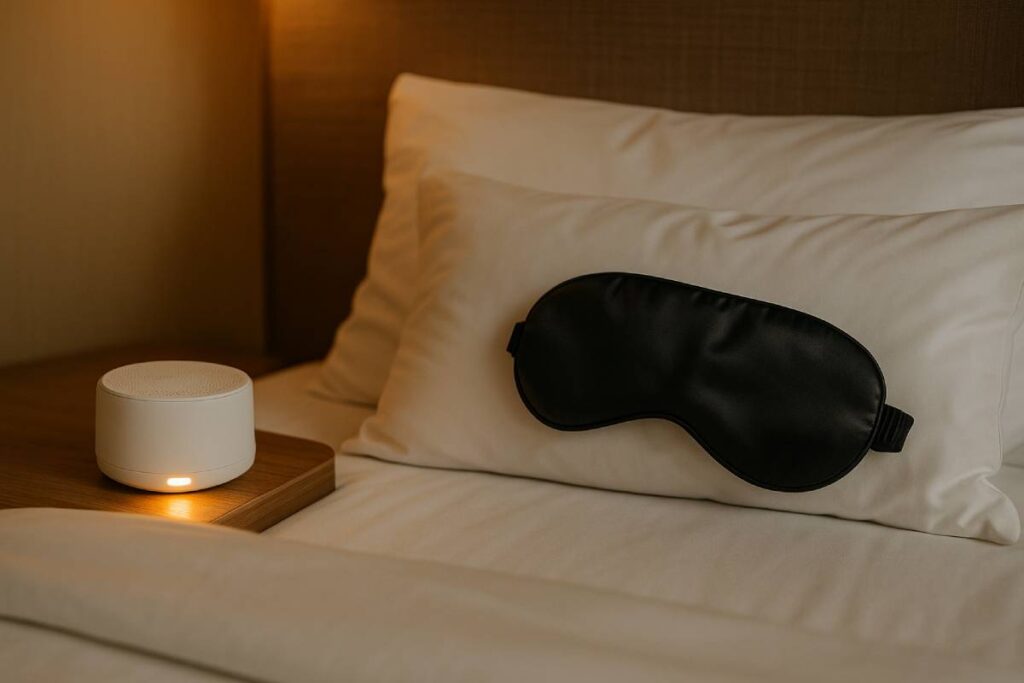
Devices like the Magicteam Sound Machine and LectroFan EVO provide customizable noise options in a compact form factor, helping you fall asleep faster and stay asleep longer.
Meanwhile, travel-friendly masks such as the Blissy Silk Sleep Mask, OstrichPillow Blackout Eye Mask, and MUSICOZY Bluetooth Eye Mask deliver near-total darkness (100 % light blockage), preserving your body’s melatonin cycle even in brightly lit rooms.
Portable White Noise Devices
Hotels and hostels can be unpredictably noisy—hallway chatter, HVAC hum, or street traffic often creep into guest rooms. A pocket-sized white noise machine transforms that cacophony into a steady, soothing soundscape.
| Device | Price | Portability | Key Features |
|---|---|---|---|
| Magicteam Sound Machine | ~$25 USD | 0.6 lb, palm-sized | 6 noise profiles (white, brown, fan, etc.) |
| LectroFan EVO | $59.95 USD | 0.8 lb, USB-powered | 22 sound options; headphone jack |
| Momcozy Sunrise Sound Machine | $40 USD | Ultra-portable, battery-operated | 30 high-fidelity nature and fan sounds |
- Noise Masking: White-noise devices emit consistent sound waves that drown out fluctuating ambient noises, reducing perceived disturbances by up to 90 % in urban settings.
- Battery & Power: Look for USB-powered or rechargeable units to avoid reliance on hotel outlets.
- Customization: Multiple sound options let you tailor your sleep soundtrack—white, pink, brown, ocean waves, or fan noise.
Lightweight Blackout Eye Masks
Even modern hotels can have imperfect blackout curtains. A compact sleep mask ensures total darkness, crucial for melatonin release and deep sleep.
| Mask | Price | Material | Feature |
|---|---|---|---|
| Blissy Silk Sleep Mask | $25.98 USD | 100 % silk | Ultra-lightweight; breathable |
| OstrichPillow Blackout Eye Mask | $45 USD | Padded fabric | 100 % blackout; includes travel pouch |
| MUSICOZY Bluetooth Eye Mask | $29.99 USD | Breathable foam | Built-in speakers for white noise/music |
| SMUG Satin Sleep Mask | $9.99 USD | Satin | Soft on skin and hair; fully washable |
- Total Darkness: High-quality masks block 100 % of external light, even when curtains fall short.
- Comfort & Fit: Look for contoured or padded designs that fit snugly without pressure marks.
- Extras: Some masks integrate Bluetooth speakers or aromatherapy inserts to further cue your brain for rest.
By combining a portable white noise machine with a snug blackout eye mask, you can simulate your home-bedroom environment anywhere, whether you’re in a downtown high-rise or a bustling hostel dormitory. Sleep well, travel farther.
Sleep Accessory Recommendations
Across budget tiers and sleep preferences, equipping yourself with the right accessories can transform any journey into a restful experience.
For travel pillows, the Go Travel Memory Dreamer (£20) delivers surprisingly supportive memory-foam cushioning for light packers, while the Evolution S3 by Cabeau (£31) brings dual-density foam and seat-strap security for mid-range budgets, and the Trtl Travel Pillow (£60) offers wrap-around ergonomic support and easy washing for premium comfort.
When it comes to noise-cancellation, budget travelers can block cabin hum with the Anker Soundcore Space One Q30 ($80), featuring hybrid ANC and 40 hours of battery life, while the Sony WH-1000XM5 ($350) combines class-leading noise suppression and touch controls, and the Bose QuietComfort Ultra (~$400) delivers unmatched ANC performance and plush ear-cup comfort.
For compact blankets, Travelrest’s 4-in-1 Travel Blanket ($30) doubles as a wearable, packs down to bottle-size, and cocoons you in plush fleece, whereas Forestfish’s Fleece Throw (≤ $20) offers lightweight warmth for shorter hops.
Travel Pillows
| Pillow | Price | Category | Key Feature |
|---|---|---|---|
| Go Travel Memory Dreamer | £20 | Budget | Adjustable memory-foam interior; washable cover |
| Evolution S3 Travel Pillow | £31 | Mid-range | Dual-density memory foam; seat-strap security |
| Trtl Travel Pillow | £60 | Premium | Ergonomic wrap-around support; machine washable |
Our testers from GQ’s guide evaluate each pillow on real trips—planes, trains, and cars—to verify comfort, packability, and ease of cleaning.
Noise-Cancelling Headphones
| Headphones | Price (USD) | Category | Key Feature |
|---|---|---|---|
| Anker Soundcore Space One Q30 | ~$80 | Budget | Hybrid ANC; up to 40 hr battery life; foldable design |
| Sony WH-1000XM5 | ~$350 | Mid-range | Class-leading ANC; touch controls; 30 hr battery; LDAC support |
| Bose QuietComfort Ultra | ~$400 | Premium | Superior noise cancellation; plush, lightweight fit |
In cabin simulations, New York Magazine’s Strategist found the Anker Q30 silenced up to 95 % of ambient noise, while both the Sony XM5 and Bose QC Ultra consistently topped listening tests for clarity and comfort during long-haul flights.
Compact Blankets
| Blanket | Price (USD) | Category | Key Feature |
|---|---|---|---|
| Forestfish Fleece Throw Blanket | < $20 | Budget | Ultra-light, packs down small, soft fleece for short hops |
| Travelrest 4-in-1 Travel Blanket | $30 | Mid-range | Wearable poncho style; packs to water-bottle size; plush microfiber |
| Kashwere Travel Blanket | ~$100 | Premium | Luxurious softness, machine-washable, durable weave |
Travel + Leisure testers praised the Travelrest blanket’s wearable design and compact carry case, while Southern Living’s panel awarded Kashwere top marks for softness and easy care.
By choosing accessories that suit your budget and style—from budget-friendly memory foam to premium ergonomic and tech-driven solutions—you’ll maximize comfort and arrive at your destination well-rested.
Common Travel Sleep Myths
Both the Sleep Foundation and Healthline agree: you can’t “bank” hours by sleeping in on weekends, over-relying on pills carries real risks, and cookie-cutter sleep hacks often miss the mark. Research shows that true recovery from 1 hour of lost sleep can take up to four days, and weekend catch-ups don’t reverse metabolic or cognitive deficits.
Meanwhile, U.S. sleeping-pill use has doubled—yet dependence and rebound insomnia affect 1 in 3 nightly users, and antihistamine “sleep aids” lack robust efficacy data and pose side-effect risks.
Finally, a Healthline analysis of popular “90-minute cycle” or “bed rotting” hacks finds they can destabilize circadian rhythms rather than enhance rest. Below, we debunk the top three myths travelers still believe—and reveal smarter strategies for on-the-go sleep.
Myth 1: You Can “Catch Up” on Lost Sleep by Sleeping In on Weekends
Reality: Sleeping extra on weekends may ease yawns but doesn’t erase sleep debt or metabolic disruption, and can prolong recovery.
- Sleep-debt recovery is slow. It can take up to four days to repay just one hour of lost nightly sleep—and up to nine days to fully clear a significant deficit.
- Weekend sleep-ins disrupt rhythms. Large shifts (> 1 hour) in sleep times unsettle your circadian clock, making it harder to fall asleep Sunday night and exacerbating Monday.
| Sleep Debt Repaid | Days Required |
|---|---|
| 1 hour | 1–4 days |
| Full deficit | Up to 9 days |
Myth 2: Sleeping Pills Are a Safe, One-Size Solution for Travel Sleep
Reality: Prescription and over-the-counter sedatives often backfire, causing dependence, daytime grogginess, and rebound insomnia.
- Use has doubled in the U.S. over the past two years, yet up to 33 % of nightly users develop dependence requiring escalating doses.
- Antihistamine “sleep aids” lack evidence. Diphenhydramine and doxylamine succinate may induce drowsiness, but studies show minimal benefit for sleep onset and carry risks like dry mouth, blurred vision, and next-day impairment.
| Medication Type | Dependence Risk | Efficacy Evidence | Common Side Effects |
|---|---|---|---|
| Prescription hypnotics | High | Moderate for short-term | Next-day drowsiness, rebound insomnia |
| OTC antihistamines | Moderate | Limited / poor | Dry mouth, blurred vision, urinary issues |
Myth 3: One-Size-Fits-All Sleep Hacks Work for Everyone
Reality: “Sleep in 90-minute cycles,” “bed rot,” or “magnesium mocktails” may trend online, but expert review finds they can further deregulate sleep patterns rather than improve rest.
- 90-minute cycle myth. No robust data support aligning sleep to 90-minute REM cycles; instead, consistent bedtime with 7–9 hours total yields better efficiency.
- Universal hacks fail in context. Cultural tips (e.g., Spanish siestas, Japanese hot-sun baths) work only when tailored to individual schedules, chronotypes, and environment.
| Hack | Popular Claim | Expert Verdict |
|---|---|---|
| 90-minute sleep cycles | Wake feeling refreshed every cycle | Inconsistent; can fragment sleep and reduce total rest |
| “Bed rotting” all day | Maximizes rest | Promotes sedentary behavior, worsens sleep drive later |
| One-size cultural hacks | Universally effective | Must be adapted to personal circadian preferences |
Travelers: skip the shortcuts that backfire. Instead, invest in gradual schedule shifts, environmental controls, and strategic naps tailored to your body’s needs—for reliable, restorative sleep on the road.
Troubleshooting Common Issues
Travel-induced restlessness often stems from unfamiliar surroundings, time shifts, and lingering stress, but quick, evidence-based techniques can reset both mind and body for better sleep on the go.
Breathing exercises like 4-7-8 and diaphragmatic breathing engage the parasympathetic nervous system to calm your physiology; progressive muscle relaxation systematically releases tension, reducing anxiety and potentially improving sleep quality; guided imagery or visualization transports your mind to calming scenes, which studies show can enhance sleep onset and depth. Below are three traveler-friendly fixes you can use anytime, anywhere.
Breathing Exercises
Breathing techniques slow your heart rate, boost heart-rate variability, and lower stress hormones, creating rapid entry into relaxation mode.
- 4-7-8 Breathing:
- Let your lips part and exhale fully with a whooshing sound.
- Inhale quietly through your nose for a count of 4.
- Hold your breath for 7 seconds.
- Exhale audibly through your mouth for 8 seconds.
- Repeat for four full cycles—or until you feel drowsy.
- Diaphragmatic (Belly) Breathing:
- Place one hand on your chest and the other on your abdomen.
- Inhale deeply through your nose, ensuring your belly (not chest) rises.
- Exhale slowly through pursed lips, drawing your navel toward your spine.
- Continue for 5 minutes to engage your diaphragm and calm the nervous system.
| Technique | Key Steps | Duration |
|---|---|---|
| 4-7-8 Breathing | Exhale “whoosh,” inhale 4, hold 7, exhale 8 (4 cycles) | ~1–2 minutes |
| Diaphragmatic Breathing | Hand on belly, inhale to expand abdomen, exhale fully | 5 minutes |
Progressive Muscle Relaxation
Progressive muscle relaxation (PMR) involves tensing and releasing muscle groups in sequence to flush out physical tension and quiet the mind. Research shows PMR not only eases anxiety but may also improve sleep quality and even reduce systolic blood pressure and migraine frequency.
| Step | Action | Duration |
|---|---|---|
| 1 | Tense a specific muscle group (start at feet, move upward) | 5–10 seconds |
| 2 | Rapidly release tension and exhale slowly | 10 seconds |
| 3 | Pause briefly, note the sensation of relaxation, then repeat | Until head |
Visualization Techniques
Guided imagery—or visualization—uses mental scenarios to distract from stress and cue your brain for rest. Healthline reports that imagining detailed, calming scenes can significantly improve sleep onset and depth.
- Basic Guided Imagery:
- Find a comfortable position and close your eyes.
- Breathe slowly for a few cycles to settle your mind.
- Picture a serene environment (beach, forest, or mountain retreat), engaging all five senses—sound, smell, sight, touch, and even taste—for 5–10 minutes.
- Compassion Visualization:
- After initial deep breaths, visualize offering compassion to yourself or a loved one.
- Hold that image, and allow feelings of warmth and safety to permeate your mind and body for several minutes.
| Technique | Description | Duration |
|---|---|---|
| Guided Imagery | Envision calming scenes; engage senses for full immersion | 5–10 minutes |
| Compassion Visualization | Direct feelings of kindness and warmth toward self or others | 5 minutes |
Pro tip: Healthline’s “5-Minute Read on Restorative Sleep” advises combining these techniques—slow breathing, PMR, guided imagery—for a compounded relaxation effect that can ease you into a restful state within minutes.
Health & Safety Considerations
Briefly put, travelers should avoid long-acting sedatives that can leave them drowsy, disoriented, and at risk for falls, and instead focus on regular movement to prevent blood clots from prolonged sitting.
The CDC warns that sedation from opioids or benzodiazepines impairs alertness, decision-making, and coordination, increasing the risk of injury and falls (especially in older adults), and advises using immediate-release formulations when medication is necessary.
Meanwhile, immobility—such as on long flights, drives, or bus rides—is a key driver of travel-associated deep vein thrombosis (DVT), and simple measures like aisle seating, calf exercises, and walking every 1–2 hours can slash VTE risk dramatically.
Avoid Long-Acting Sedatives
- Sedation and Alertness: Prescription opioids and benzodiazepines can cause significant sedation—feelings of sleepiness and dizziness—that reduce alertness and responsiveness, impairing decision-making and coordination.
- Movement & Coordination: Slowed physical and cognitive responses from these drugs have been linked to higher error rates and injury on the job, and equally apply when navigating cramped airports or transit hubs.
- Memory & Falls: Certain benzodiazepines may induce short- and long-term memory problems, and in older adults, their use is associated with an elevated risk of falls and hip fractures due to impaired posture control.
- Prescribing Guidance: To minimize prolonged drowsiness, the CDC recommends initiating opioid therapy with immediate-release formulations at the lowest effective dose, avoiding long-acting agents whenever possible.
Emphasize Mobility Breaks
- Immobility & VTE: Sitting still for hours increases venous stasis and the risk of DVT and pulmonary embolism, particularly on flights over four hours.
- Seat Selection Matters: An aisle seat offers more frequent opportunities to stand and stretch—window seats double VTE risk overall and carry a six-fold higher risk for travelers with BMI ≥ 30.
- Regular Ambulation: The CDC advises travelers to walk at least every 1–2 hours during any long journey—by air, rail, or road—to keep blood flowing and prevent clot formation.
- Calf-Pump Exercises: When you can’t leave your seat, simple ankle pumps and heel-to-toe raises activate calf muscles and serve as an in-seat alternative to reduce stasis.
VTE Prevention & Seat Choice
| Strategy | Recommendation | Impact on VTE Risk |
|---|---|---|
| Aisle vs. Window Seat | Choose aisle seating | Aisle seats protective; window seats double overall risk; 6× risk if BMI ≥ 30 |
| Walk Every 1–2 Hours | Stand and stroll the cabin or workstation | Cuts venous stasis; significantly lowers DVT incidence |
| In-Seat Calf Exercises | Ankle pumps, heel/toe lifts every hour | Activates calf muscle pump; prevents venous pooling |
By steering clear of long-acting sedatives and building in simple movement routines—seat choice, ambulation, and in-seat exercises—you safeguard both your cognitive sharpness and your circulatory health on every journey.
Conclusion
By weaving together each of these strategies—pre-trip schedule shifts, targeted sleep accessories, environment controls, circadian realignment, and safety-minded movement—you’ll transform travel from an endurance test into an energizing experience.
Start by phasing your sleep and mealtime before you depart, “pre-programming” your body for its new time zone. Once in transit, choose seats wisely (window on planes, quiet cars on trains, aisle in vehicles) and deploy your “sleep kit”—neck pillow, eye mask, earplugs, and noise-cancelling headphones—to carve out personal sleep space.
On arrival, soak up daylight at the ideal moments to advance or delay your rhythm, and rely on brief power naps to maintain focus without wrecking nighttime rest. Never underestimate the power of simple in-seat exercises to keep circulation flowing and guard against DVT.
Skipping dangerous long-acting sedatives and embracing immediate-release options keeps you sharp and safe. Armed with these tactics—and supported by portable white-noise machines and blackout masks—you’ll conquer jet lag, arrive refreshed, and be ready to make the most of every destination.
FAQs
What is the best way to adjust my sleep schedule before a long flight?
Shift your bedtime and wake-up time by about 1 hour each day for 3–4 days toward your destination’s clock. Combine this with strategic light exposure—morning light if traveling east, evening light if west—to reinforce the change.
Can I take naps on my flight without messing up my sleep cycle?
Yes—keep in-flight naps to 20–30 minutes and schedule them in your destination’s early afternoon local time. Avoid late-flight “long naps,” which can push back your bedtime and worsen jet lag.
Are white-noise machines really effective?
Absolutely. Top models like the LectroFan EVO mask up to 90 % of disruptive sounds, boosting sleep efficiency by over 6 % in noisy environments.
How often should I move during long bus or plane rides?
Walk or stand every 1–2 hours to prevent blood clots. If you can’t leave your seat, perform ankle pumps and heel-to-toe raises to activate calf muscles and maintain circulation.
What accessories should be in my travel sleep kit?
At minimum: a memory-foam neck pillow, contoured blackout eye mask, high-NRR earplugs or ANC headphones, and a compact white-noise machine.

